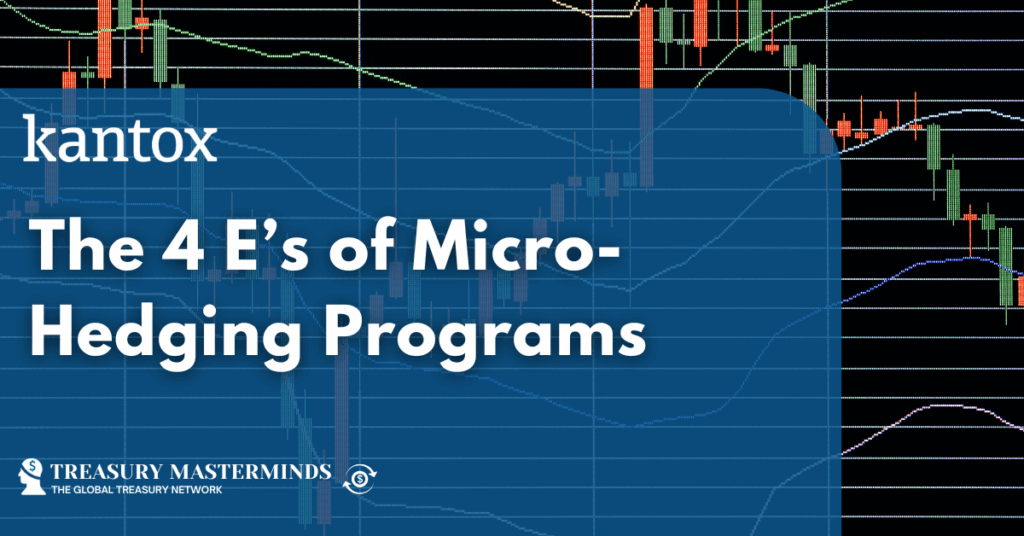
The 4 E’s of Micro-Hedging Programs
This article is written by Kantox This blog explains the nuts and bolts of micro-hedging programs and the benefits they provide to corporations. By using micro-hedging programs —either on a standalone basis or in combination with other programs—, finance teams are in a unique position to: So let’s dive in and explain how companies can profit from these four E’s. Eliminate FX risk. Enhance control. Earn more. Embrace currencies. Micro-hedging programs are API-based software solutions that allow corporate treasury teams to effectively hedge their exposure to currency risk —whatever the number of transactions— with a high degree of automation, visibility, and control. They are emerging as a key element in most corporate FX hedging strategies. The versatility and ease-of-use of micro-hedging programs, even when many currency pairs are involved, are proving themselves a must-have in different setups: The first “E”: eliminate currency risk At first sight, the notion that currency risk can be removed with great precision, even when many transactions in different currency pairs are processed, may seem a bit outlandish. To understand how micro-hedging works, the notion of market monitoring plays a key role. Thanks to API connectivity, stop-loss and take-profits are set around the FX rate at which a piece of exposure known as an entry —a firm order or an invoice— is received from company systems (ERP, TMS, others). As long as the FX rate trades inside this corridor, new entries are accumulated into positions. Because each entry arrives at a different moment, and therefore at a different exchange rate, the system needs to automatically calculate the weighted average exchange rate. When either of the boundaries of the range is hit, the position is automatically hedged. From the FX risk management point of view, the benefits of this procedure include: But what about hedging precision? Here’s precisely the point. When the drill is performed during sufficiently long periods of time, something interesting happens: “Over time, the stop-loss and take-profit orders tend to offset each, resulting in fluctuations around a central point. While financial time series exhibit skewness and other complexities, the overall risk typically decreases as the process unfolds” — Andrea Perissinotto, FX Data Analyst Team Lead, Kantox And that’s how micro-hedging virtually eliminates FX risk, either in the context of transaction risk or in terms of accounting risk. The second “E”: enhance control In our blog Debunking 4 Currency Management Myths: Protecting Profit Margins in 2025, we discussed some myths surrounding FX hedging. We could have included another one: the notion that automation weakens managers’ control over their hedging programs. In fact, the opposite happens. Currency Management Automation makes it possible for finance teams to strengthen control throughout the different phases of the FX workflow. To illustrate the point, treasurers can, at any point in time: When it comes to validating exposure data, treasurers can enforce a manual validation process according to different criteria in terms of amount, maturity, and currencies. Checkpoints are also available during the trade and post-trade phases. By way of example, Nutrien, a Canadian crop inputs provider, recently announced a $220m loss on FX derivatives transactions in Brazil: “We recorded a foreign exchange loss of $220 million on foreign currency derivatives in Brazil for the second quarter of 2024 […] we have a material weakness related to our controls over derivative contract authorization in Brazil” — Nutrien The company blames “an individual outside applicable internal policy and authority”. How do automated micro-hedging programs deal with this issue? From the outset, any derivatives transaction is numerically traced back to the corresponding exposure. A fraudulent trade will thus have a very hard time progressing from the ‘pre-trade’ to the ‘trade’ phase. Traceability and control Control is also enhanced by the traceability feature of micro-hedging programs. Across the journey from entry to position, to conditional order, to operation, and to payment, each element has its own unique reference number. In addition, payments carry the operation reference within their SWIFT message, allowing funds to be traced throughout the entire payment process. Whenever a position is hedged, it is possible to trace it back to the original entries, including the exchange rate. This is called end-to-end traceability. Among other control-related tasks, it makes it possible to: The third “E”: earn more The third “E” of micro-hedging programs can be illustrated with a simple proposition: improve profit margins by always contracting in the cheapest currency. With currency risk under control, managers avoid the misplaced temptation of buying directly in their firm’s own currency. The truth is that the underlying FX risk never goes away — it is merely transferred onto suppliers, who then apply markups to protect themselves from the underlying risk. By removing this friction, markups are sidestepped, and contracting costs are reduced. This example from the Travel industry illustrates the point: (*) Note that the margin increases to 5.5% by using the forward rate of 0.9730 instead. Forward points are favourable because —as interbank interest rates are higher in the U.S. than in Europe— the exchange rate translates into a higher forward EUR value, compared to spot. This gain can be used to reduce contracting costs. The fourth “E”: embrace currencies The fourth “E” of micro-hedging programs —embrace currencies— flows from the previous three. With FX risk under control, enhanced control over the workflow, and supplier markups out of the way, managers can confidently sell in more currencies. Thanks to Multi-Dealer Platforms such as 360T, to which micro-hedging programs are connected, treasurers can execute trades —in favourable liquidity conditions— in the currencies of a number of small, but well-managed economies: SEK, NOK, CAD, AUD, NZD, SGD, and KRW. A recent Amadeus survey about consumers’ attitudes shows: For firms with international operations, the conclusion is simple: you should sell in the currency of your customers. Some of the benefits include: This is happening already. A Bloomberg News article shows evidence that currency managers are sidestepping USD to conduct business in other currencies. French firms Saint-Gobain, Bouygues Construction, Veolia, and Neoven are increasing…

Visa Exits U.S. Open Banking — What Corporate Treasurers Should Know
From Treasury Masterminds 1. Recent Developments: Visa Shutters U.S. Open Banking Unit In late August 2025, payments giant Visa decided to shut down its open banking operations in the United States. The unit had offered fintechs streamlined access to bank account data, helping with onboarding and transfers. However, heightened disputes between banks and fintech firms over data access fees ultimately prompted this retreat. Visa has instead shifted its focus toward Europe and Latin America, where regulatory frameworks mandate data sharing with authorized entities. In the U.S., the Consumer Financial Protection Bureau (CFPB) is revising regulations to strengthen consumer control over financial data sharing, based on Section 1033 of the Dodd-Frank Act. UPCOMING PODCAST Join us for “From Treasurer to TMS Trailblazer” with Quique Fernandez of Embat and discover how treasury leaders can shape the future of tech. Click below to register now and attend! 2. U.S. vs. EU: Open Banking Regimes in Contrast Europe (EU and UK) United States 3. Section for Treasurers: Practical Implications For corporate treasurers, these shifts hold tangible implications: Access & Integration Cost & Negotiation Dynamics Regulatory Compliance & Risk Strategic Impacts 4. Data: The Real Gold of Open Banking At its core, open banking isn’t just about APIs, payments, or fintech connectivity — it’s about data. Without reliable, high-quality data, open banking loses much of its value. For corporate treasurers, this means the real competitive advantage lies in how well you manage and leverage data flows. Those who invest in connectivity and ensure their internal data is structured, accurate, and ready will be best placed to extract value from open banking — regardless of whether the system leans toward monetization (U.S.) or mandated sharing (EU). 5. Conclusion Visa’s exit from U.S. open banking underscores the growing tension between banks and fintechs. The U.S. remains in a transitional phase, with new rules on the horizon but heavy pushback from incumbents. Europe, on the other hand, has a mature framework in place and is expanding into broader open finance models. Key takeaway for treasurers: If you operate in Europe, open banking already offers tangible opportunities for innovation and efficiency. If you’re focused on the U.S., prepare for a longer journey — monitor CFPB developments closely, ensure your treasury systems are flexible, and be ready to adapt as the landscape evolves. Also Read Join our Treasury Community Treasury Mastermind is a community of professionals working in treasury management or those interested in learning more about various topics related to treasury management, including cash management, foreign exchange management, and payments. To register and connect with Treasury professionals, click [HERE] or fill out the form below to get more information. Notice: JavaScript is required for this content.